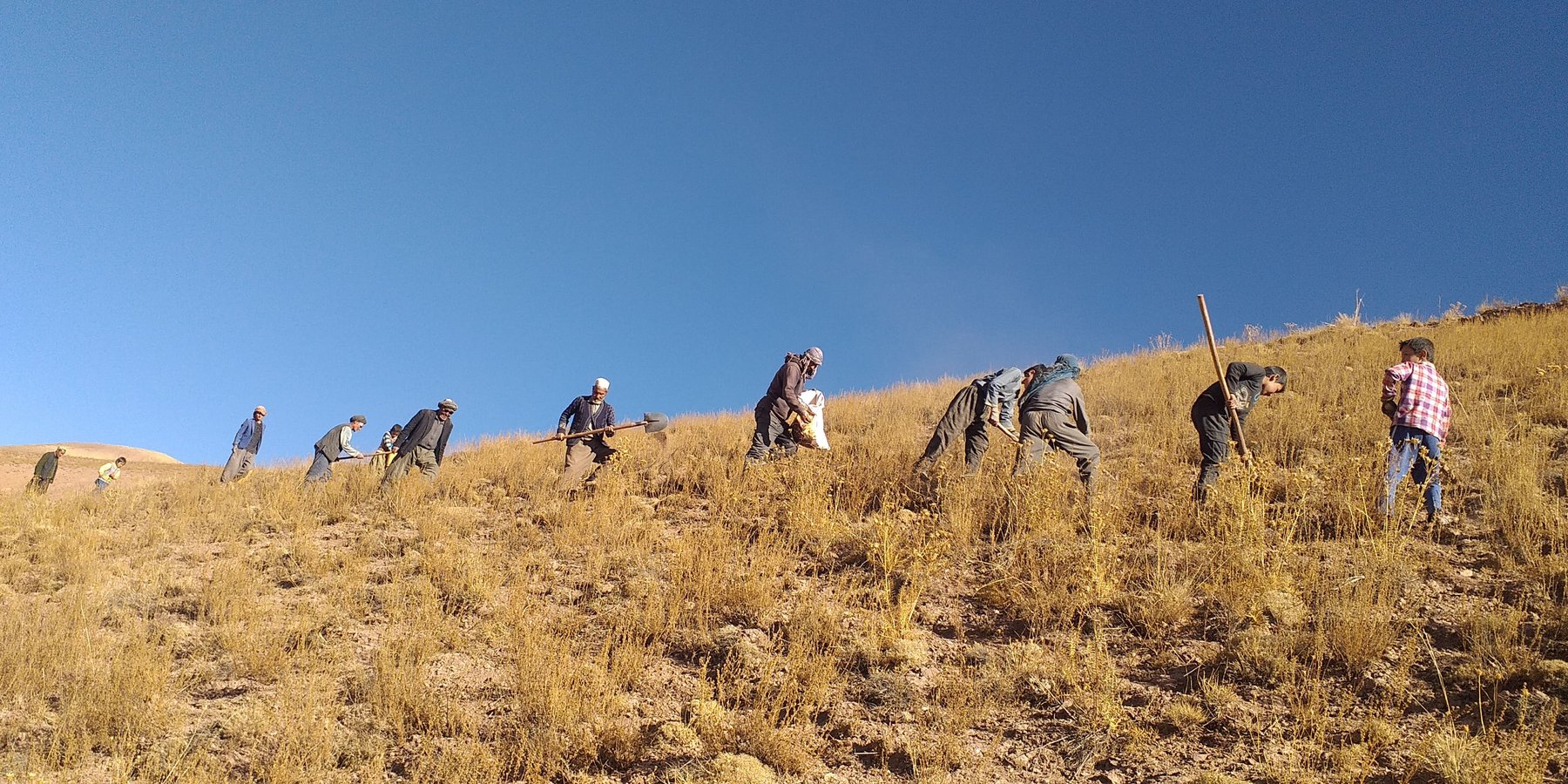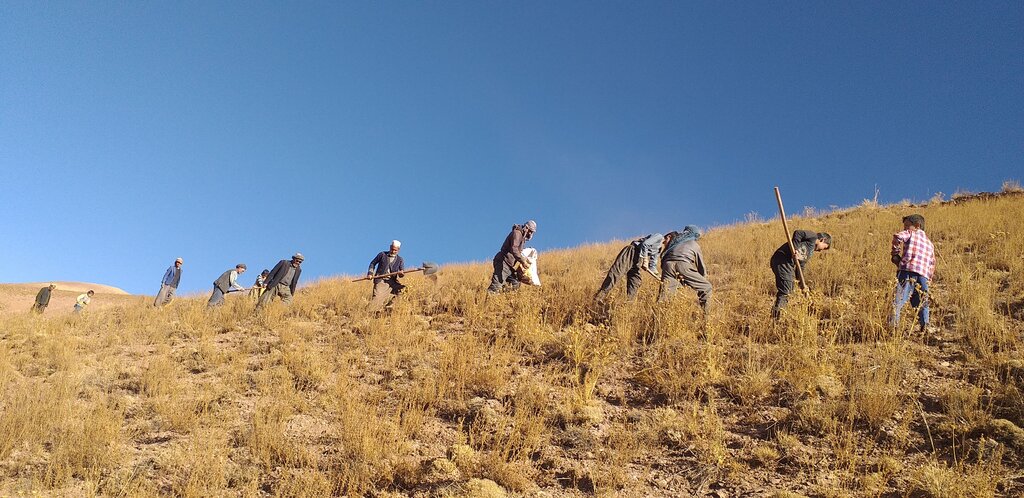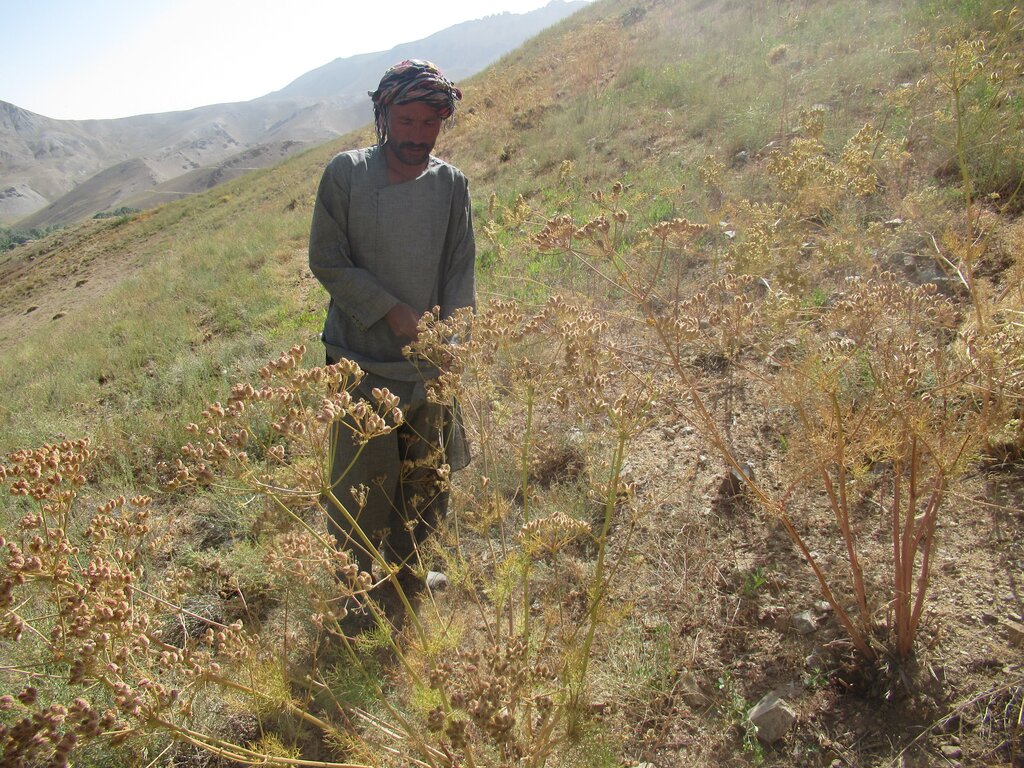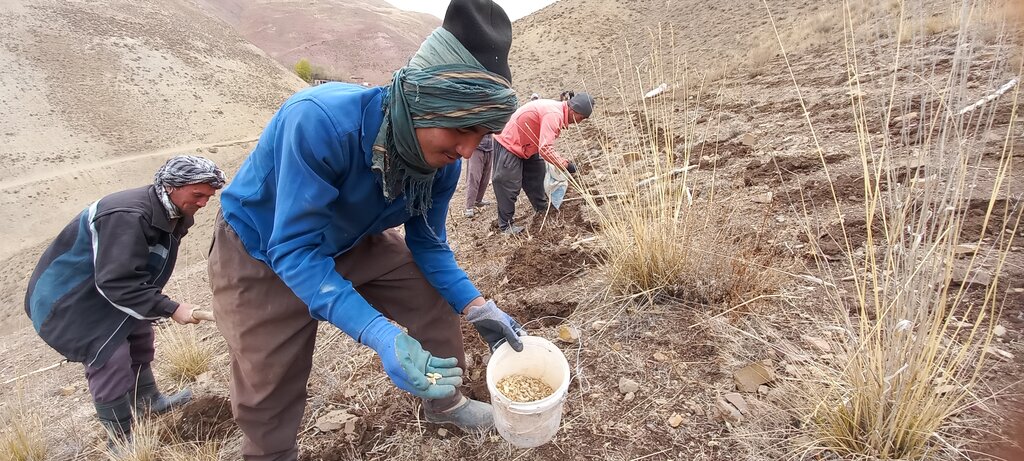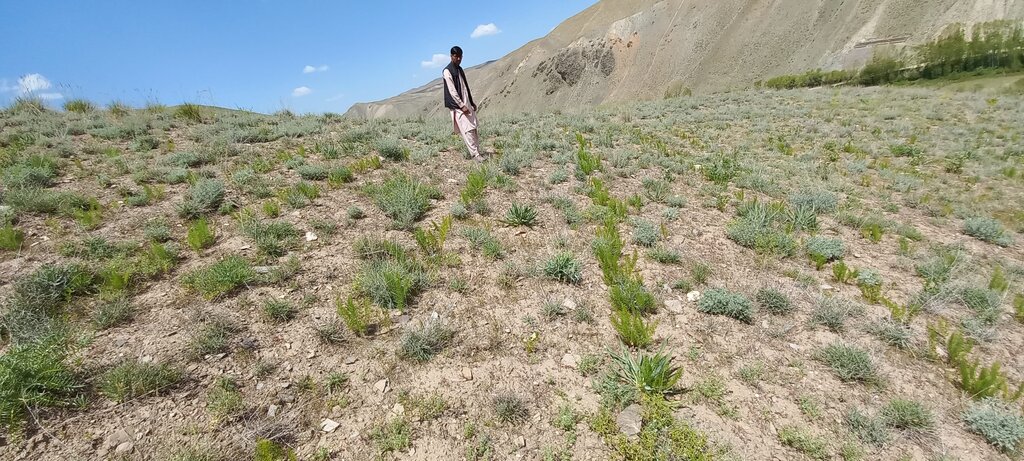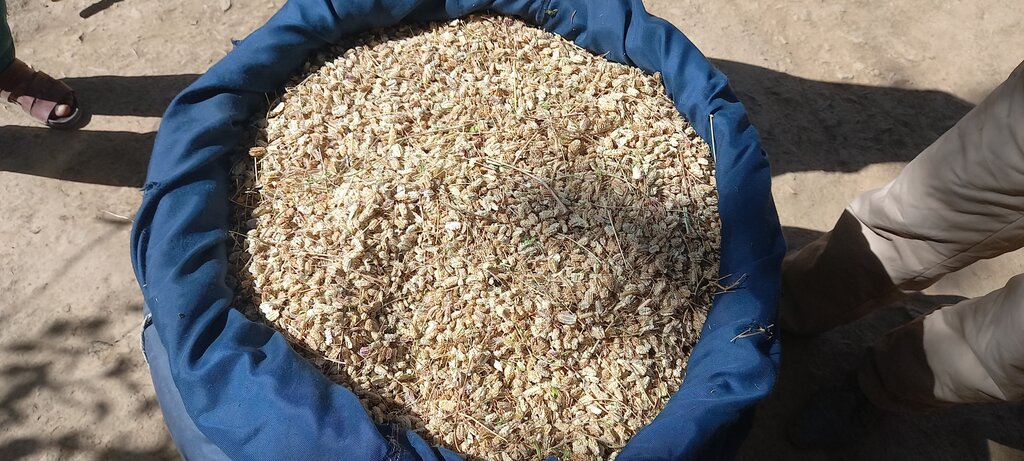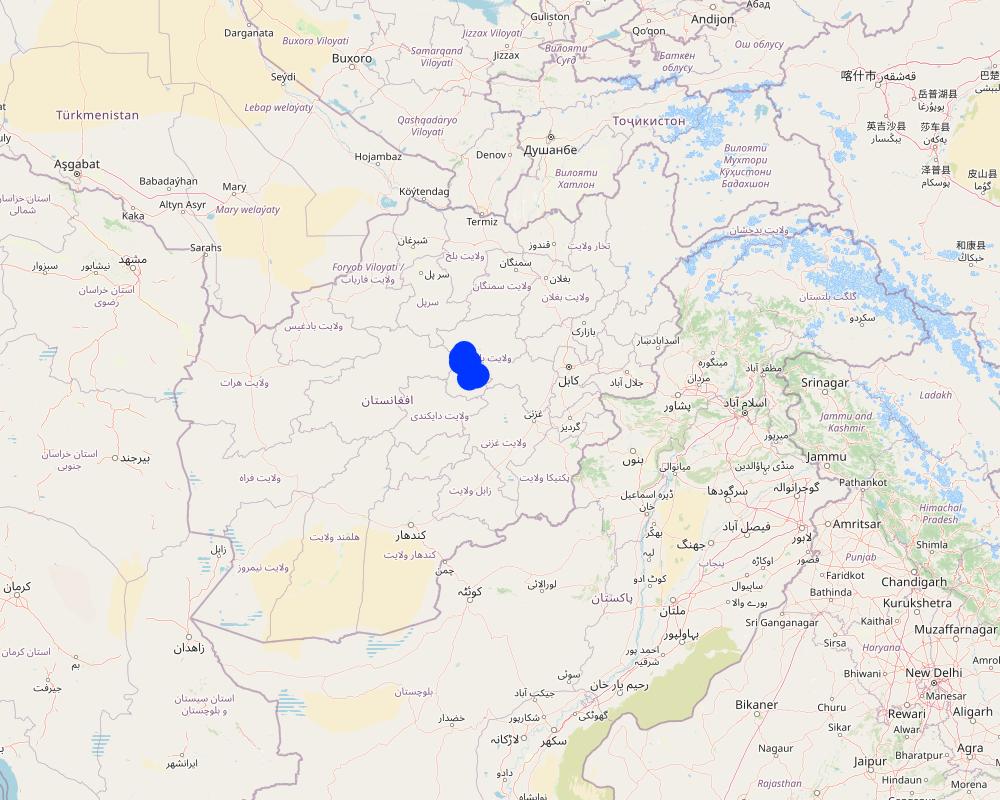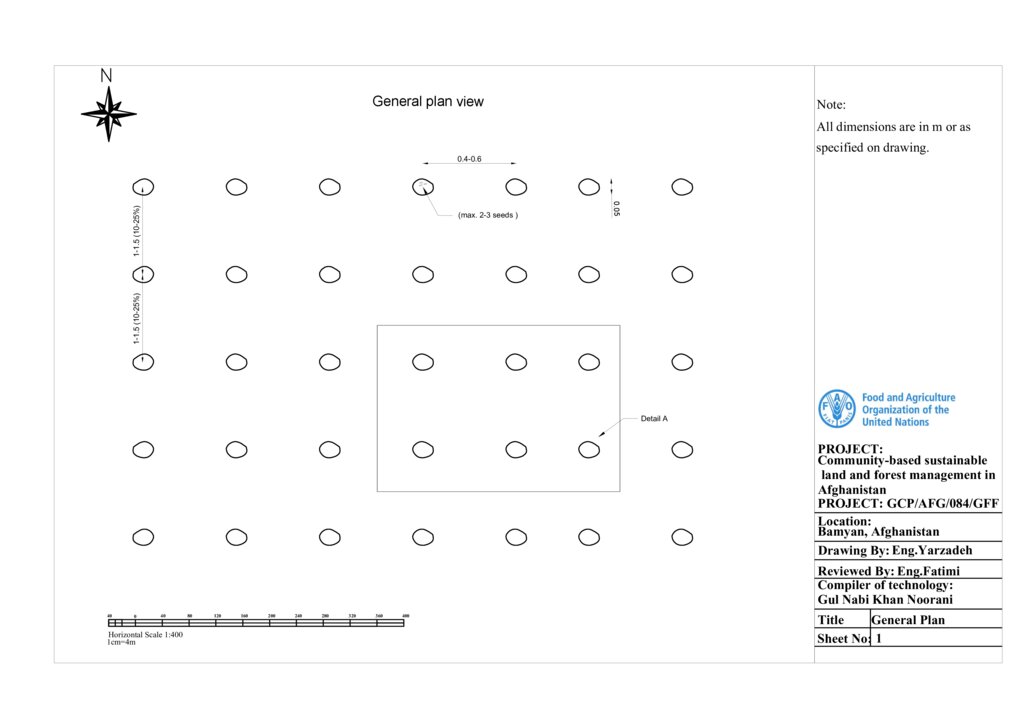Reseeding local fodder species in Bamyan rangelands using indigenous and scientific methods [อัฟกานิสถาน]
- ผู้สร้างสรรค์:
- การอัพเดท:
- ผู้รวบรวม: Gul Nabi Khan Noorani
- ผู้เรียบเรียง: Mir Wali Khan Lakanwal, Mohammad Mustafa Sahebzada
- ผู้ตรวจสอบ: Rima Mekdaschi Studer
کاشت انواع علوفه جات محلی در علفچرهای بامیان با استفاده از رویشهای های بومی و علمی
technologies_7402 - อัฟกานิสถาน
- บทสรุปทั้งหมดในรูปแบบของ PDF
- บทสรุปทั้งหมดในรูปแบบของ PDF เพื่อพิมพ์
- บทสรุปทั้งหมดในรูปหน้าเว็บ
- บทสรุปทั้งหมด (ไม่มีการจัดเรียง)
- Reseeding local fodder species in Bamyan rangelands using indigenous and scientific methods: 27 มกราคม 2025 (inactive)
- Reseeding local fodder species in Bamyan rangelands using indigenous and scientific methods: 24 มีนาคม 2025 (inactive)
- Reseeding local fodder species in Bamyan rangelands using indigenous and scientific methods: 6 พฤษภาคม 2025 (public)
ดูส่วนย่อย
ขยายทั้งหมด ย่อทั้งหมด1. ข้อมูลทั่วไป
1.2 รายละเอียดที่ติดต่อได้ของผู้รวบรวมและองค์กรที่เกี่ยวข้องในการประเมินและการจัดเตรียมทำเอกสารของเทคโนโลยี
Technician:
Alamy Sayed Basir
FAO Afghanistan
อัฟกานิสถาน
Volunteers:
Masror Sayed Taqi
Volunteer Community Facilitator
อัฟกานิสถาน
Volunteer:
Mohseenpor Sayed Azim
Volunteer Community Facilitator
อัฟกานิสถาน
ผู้ใช้ที่ดิน:
Arvin Ali
Volunteer Community Facilitator
อัฟกานิสถาน
Volunteer:
Wafa Sayed Ihsan
Volunteer Community Facilitator
อัฟกานิสถาน
ผู้ใช้ที่ดิน:
The RMA Members
Members of Rangeland Management Associations in two target districts.
อัฟกานิสถาน
ชื่อของโครงการซึ่งอำนวยความสะดวกในการทำเอกสารหรือการประเมินเทคโนโลยี (ถ้าเกี่ยวข้อง)
Community-based sustainable land and forest management in Afghanistanชื่อขององค์กรซึ่งอำนวยความสะดวกในการทำเอกสารหรือการประเมินเทคโนโลยี (ถ้าเกี่ยวข้อง)
FAO Afghanistan (FAO Afghanistan) - อัฟกานิสถาน1.3 เงื่อนไขการใช้ข้อมูลที่ได้บันทึกผ่านทาง WOCAT
ผู้รวบรวมและวิทยากรหลักยอมรับเงื่อนไขเกี่ยวกับการใช้ข้อมูลที่ถูกบันทึกผ่านทาง WOCAT:
ใช่
1.4 การเปิดเผยเรื่องความยั่งยืนของเทคโนโลยีที่ได้อธิบายไว้
เทคโนโลยีที่ได้อธิบายไว้นี้เป็นปัญหาของความเสื่อมโทรมโทรมของที่ดินหรือไม่ จึงไม่ได้รับการยอมรับว่าเป็นเทคโนโลยีเพื่อการจัดการที่ดินอย่างยั่งยืน:
ไม่ใช่
แสดงความคิดเห็น:
The technology is sustainable and easily replicable by local communities.
2. การอธิบายลักษณะของเทคโนโลยี SLM
2.1 การอธิบายแบบสั้น ๆ ของเทคโนโลยี
คำจำกัดความของเทคโนโลยี:
Artificial reseeding is a key method for restoring degraded rangelands. It involves reintroducing native, palatable fodder species to improve vegetation cover, soil health, and biodiversity. This process boosts forage for grazing animals, stabilizes soil, and helps combat desertification, enhancing ecosystem health and productivity.
2.2 การอธิบายแบบละเอียดของเทคโนโลยี
คำอธิบาย:
The Food and Agriculture Organization (FAO) project of “Community-based sustainable land and forest management in Afghanistan” aimed to conserve vegetation cover and ecosystems through introducing community-based sustainable land and forest management (SLM/SFM) practices in rangeland and forest areas within five targeted provinces, including Bamyan, that benefited rural communities that rely on these ecosystems for their livelihood. The project introduced an integrated, community-based approach of SLM/SFM in Afghanistan for promoting biodiversity conservation, climate change mitigation, and rangeland productivity.
To enhance rangeland productivity in Bamyan province, artificial reseeding of native, locally adapted, and drought-resistant fodder species plays a vital role in restoring health and productivity of the degraded rangeland ecosystem, improving soil quality, and increasing fodder availability for livestock, which contributed to local livelihoods and environmental resilience.
Communities carefully identify highly vulnerable and degraded rangelands for reseeding initiatives. These include previously rain-fed wheat fields cultivated for human consumption, overgrazed sites, and areas with restricted grazing to support vegetation recovery before reseeding. Attention is also given to areas prone to snow avalanches and flash floods causing landslides and soil erosion, which impact downstream residential areas, irrigation systems, trails, roads, and farmlands. These zones are prioritized and mutually agreed upon for reseeding and restoration efforts.
This reseeding local fodder species technology involves several key activities.
1.Identification of locally adapted drought-resistant and palatable fodder species by livestock owners and land users.
2.Identification of highly producing areas of selected fodder species to collect quality seeds.
3.Defer grazing and delay fodder harvest for the purpose of seed maturity in the targeted area.
4.Awareness raising about the maturity stages of different fodder species seeds: Through project intervention and awareness campaigns, rural residents have gained a better understanding of the seed ripening, collecting, and cultivation stages.
5.Collecting, drying, and storing seed: The fodder species’ seeds are collected manually by hand. These fodder species produce longer main stems with inflorescence and spikelets on the top at an average person's breast height. Collected seed is brought to the storing facility and laid out under sunlight for drying. Once seed reaches a certain moisture content, it's stored in a cool and dry place until the day of reseeding under the direct supervision of the rangeland management association (RMA).
6.Season of reseeding local fodder seed: Reseeding activities typically begin in the autumn season, just before the first snowfall. Seeds remain in the soil throughout the winter, allowing them to overcome dormancy and germinate in the spring of the following year. Local fodder species used for reseeding include various Fennel species and other plants traditionally relied upon for winter fodder. These include: Umbelliferae ferulus (Gheghu), Winklera silaifolia (Pali), Prangos sp. (Kami), Ferula sp. (Badran), Rheum spp. (Chukri), Koeleria cristata (Khola), a shrub locally known as Qarghna.
7.Method of Reseeding: The inter and intra-row space between seeding pits (max. 2-3 seeds in one pit) depends on the slope of the terrain, canopy of the fodder, and extent of vegetation cover. If the % slope of the terrain is increasing and canopy of planted species is small, then the space between two rows and two plants decreases and vice versa. Normally, the space between two rows is 1-1.5 m and two plants are about 40-60 cms apart. On the day of reseeding, some land users dig small pits using a hoe and shovel approximately five centimeters deep, followed by another person who puts seeds in the pit and covers the seed with soil using his own boot. The distance between pits is estimated through a person's step. One person reseeds 3.5 kgs of seed per working day. Roughly, a total of 15 kgs of fodder seed is needed for 1 ha of rangeland. It's worth mentioning that the quantity of seed per ha depends on the space between rows and plants and the size of the fodder seed itself.
The seeds are collected using the cash-for-work model. This served (i) to provide income support to poor, vulnerable men and women through short-term employment and (ii) to rehabilitate public assets (rangelands) that are vital for sustaining the livelihoods of livestock rearing. Both men and women-headed vulnerable households benefited from the cash-for-work program of seed collection. More importantly, these fodder species’ seeds are fresh, locally adapted, nutritious for livestock (help fatten livestock), available locally, and inexpensive compared to other types of fodder seed. The germination percentage of the seed and growth of the fodder is significantly high in the reseeded area.
Traditionally, rural communities knew that fodder crops grew from seeds; however, the main stems with inflorescences and spikelets were harvested before maturity and used as fuelwood for heating and cooking. Through awareness-raising campaigns and training workshops within the project, farmers were encouraged to leave the main stems intact for seed maturation, allowing for natural seed dispersal and seed collection for reseeding. The success of natural reseeding is limited compared to artificial reseeding due to several factors. In natural reseeding, seeds are often exposed and not covered by soil, making them vulnerable to environmental conditions. Moisture availability may also be insufficient for germination, and existing vegetation can compete with new growth. In contrast, artificial reseeding ensures that seeds are properly covered, protected, and placed in areas with optimal moisture, which increases the likelihood of successful germination and establishment. Recently, the demand for the local fodder seed has dramatically increased because many non-profit organizations and private businesses are purchasing these seeds. It created a new source of income for the rural communities.
Finally, the technology combines both traditional knowledge and scientific understanding, contributing to more effective restoration of the degraded rangeland ecosystem, improving soil health, and increasing fodder availability, which contributed to livelihood resilience and improvement.
2.3 รูปภาพของเทคโนโลยี
2.4 วีดีโอของเทคโนโลยี
ความคิดเห็น/อธิบายสั้นๆ:
The video shows the reseeding of local fodder seeds in degraded rangelands, contributing to land restoration and improved fodder availability.
วันที่:
28/10/2024
สถานที่:
Balderghoto village, Punjab district Bamyan province
ชื่อผู้ถ่ายวีดีโอ:
Gul Nabi Khan
ความคิดเห็น/อธิบายสั้นๆ:
The video shows the result of reseeding local fodder species, such as Umbelliferae Ferula and Prangos sip., showed improved vegetation cover, enhanced soil stabilization, increased forage availability for livestock, and greater ecosystem resilience.
วันที่:
03/06/2023
สถานที่:
Village Kandogak, RMA Sayed Bacha, Punjab district Bamyan
ชื่อผู้ถ่ายวีดีโอ:
Gul Nabi Khan
2.5 ประเทศภูมิภาค หรือสถานที่ตั้งที่เทคโนโลยีได้นำไปใช้และได้รับการครอบคลุมโดยการประเมินนี้
ประเทศ:
อัฟกานิสถาน
ภูมิภาค/รัฐ/จังหวัด:
Bamyan
ข้อมูลจำเพาะเพิ่มเติมของสถานที่ตั้ง :
Punjab and Yakawalang districts
ระบุการกระจายตัวของเทคโนโลยี:
- ใช้ ณ จุดที่เฉพาะเจาะจงหรือเน้นไปยังบริเวณพื้นที่ขนาดเล็ก
Is/are the technology site(s) located in a permanently protected area?
ไม่ใช่
แสดงความคิดเห็น:
These sites are subject to a five-year quarantine following the reseeding activity, meaning that they are designated off-limits for grazing, shrub gathering, and fodder harvesting during this period.
Map
×2.6 วันที่การดำเนินการ
ระบุปีที่ใช้:
2021
2.7 คำแนะนำของเทคโนโลยี
ให้ระบุว่าเทคโนโลยีถูกแนะนำเข้ามาอย่างไร:
- ทางโครงการหรือจากภายนอก
ความคิดเห็น (ประเภทของโครงการ เป็นต้น) :
The Food and Agriculture Organization's (FAO) project of “Community-based sustainable land and forest management in Afghanistan” is an environmental project funded by Global Environmental Facility (GEF) which focused on reducing land degradation, enhance biodiversity and climate change mitigation.
3. การจัดประเภทของเทคโนโลยี SLM
3.1 วัตถุประสงค์หลักของเทคโนโลยี
- ปรับปรุงการผลิตให้ดีขึ้น
- ลด ป้องกัน ฟื้นฟู การเสื่อมโทรมของที่ดิน
- อนุรักษ์ระบบนิเวศน์
- รักษาสภาพหรือปรับปรุงความหลากหลายทางชีวภาพ
- ปรับตัวเข้ากับการเปลี่ยนแปลงภูมิอากาศของโลก สภาพภูมิอากาศที่รุนแรงและผลกระทบ
3.2 ประเภทของการใช้ที่ดินในปัจจุบันที่ได้นำเทคโนโลยีไปใช้
Land use mixed within the same land unit:
ไม่ใช่
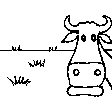
ทุ่งหญ้าเลี้ยงสัตว์
Extensive grazing:
- กึ่งโนแมนดิซึ่มหรือแพสโตแรลลิซึ่ม (Semi-nomadism/pastoralism)
ทุ่งหญ้าเลี้ยงสัตว์ที่มีการจัดการแบบเข้มข้นหรือการผลิตอาหารสัตว์:
- ทุ่งหญ้าเลี้ยงสัตว์ที่ได้มีการปรับปรุง (Improved pastures)
- Direct grazing and remaining fodder is cut for animal feeding
Animal type:
- cattle - dairy
- goats
- sheep
Is integrated crop-livestock management practiced?
ไม่ใช่
ผลิตภัณฑ์และบริการ:
- meat
- milk
- whool
Species:
sheep
Count:
647703
Species:
goats
Count:
250869
Species:
cattle - dairy
Count:
165274
แสดงความคิดเห็น:
It has been agreed among community members that, following the reseeding program, the area will be quarantined for at least 4-5 years. During this period, no grazing, shrub collection, or fodder harvesting will be allowed in order to enhance vegetation coverage.
The exact number of livestock in the reseeding area of the rangeland is currently unknown, as no formal count has been conducted. The numbers provided reflect an estimated count of livestock in the target districts of Yakawlang 1 and Punjab. The data was sourced from the Department of Livestock and Animal Health of the Provincial Directorate of Agriculture, Livestock, and Irrigation of Bamyan.
3.3 Has land use changed due to the implementation of the Technology?
Has land use changed due to the implementation of the Technology?
- Yes (Please fill out the questions below with regard to the land use before implementation of the Technology)
Land use mixed within the same land unit:
ใช่
Specify mixed land use (crops/ grazing/ trees):
- Agro-pastoralism (incl. integrated crop-livestock)

พื้นที่ปลูกพืช
- การปลูกพืชล้มลุกอายุปีเดียว
Annual cropping - Specify crops:
- cereals - wheat (spring)
Is intercropping practiced?
ไม่ใช่
Is crop rotation practiced?
ไม่ใช่
3.4 การใช้น้ำ
การใช้น้ำของที่ดินที่มีการใช้เทคโนโลยีอยู่:
- จากน้ำฝน
แสดงความคิดเห็น:
The rangeland is rainfed and experiences heavy snowfall during the winter season.
3.5 กลุ่ม SLM ที่ตรงกับเทคโนโลยีนี้
- การปิดล้อมพื้นที่ (หยุดการใช้ประโยชน์ สนับสนุนการฟื้นฟู)
- การจัดการปศุสัตว์และทุ่งหญ้าเลี้ยงสัตว์
- การปรับปรุงดิน / พืชคลุมดิน
- rangeland restoration
3.6 มาตรการ SLM ที่ประกอบกันเป็นเทคโนโลยี
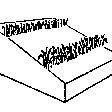
มาตรการอนุรักษ์ด้วยวิธีพืช
- V2: หญ้าและไม้ยืนต้น
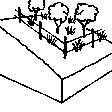
มาตรการอนุรักษ์ด้วยการจัดการ
- M1: การเปลี่ยนรูปแบบของการใช้ประโยชน์ที่ดิน
แสดงความคิดเห็น:
The land is closed/rested for both natural and artificial vegetation to recover.
3.7 รูปแบบหลักของการเสื่อมโทรมของที่ดินที่ได้รับการแก้ไขโดยเทคโนโลยี
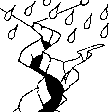
การกัดกร่อนของดินโดยน้ำ
- Wt (Loss of topsoil): การสูญเสียดินชั้นบนหรือการกัดกร่อนที่ผิวดิน
- Wg (Gully erosion): การกัดกร่อนแบบร่องธารหรือการทำให้เกิดร่องน้ำเซาะ
- Wm (Mass movement): การเคลื่อนตัวของมวลดินหรือดินถล่ม
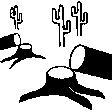
การเสื่อมโทรมของดินทางด้านชีวภาพ
- Bc (Reduction of vegetation cover): การลดลงของจำนวนพืชที่ปกคลุมดิน
- Bh (Loss of habitat): การสูญเสียแหล่งที่อยู่
- Bq (Quantity/biomass decline): การลดลงของปริมาณหรือมวลชีวภาพ
- Bs (Quality and species composition): องค์ประกอบหรือความหลากหลายทางคุณภาพและชนิดพันธุ์ลดลง
แสดงความคิดเห็น:
Reseeding of various fodder crops help control soil degradation by restoring plant cover, which stabilizes the soil and reduces erosion. Soil cover reduces loss of fertile soil and can increase soil organic matter that then can lead to improved fertility.
3.8 การป้องกัน การลดลง หรือการฟื้นฟูความเสื่อมโทรมของที่ดิน
ระบุเป้าหมายของเทคโนโลยีกับความเสื่อมโทรมของที่ดิน:
- ป้องกันความเสื่อมโทรมของที่ดิน
- ฟื้นฟูบำบัดที่ดินที่เสื่อมโทรมลงอย่างมาก
แสดงความคิดเห็น:
Reseeding technology helps restore degraded land by introducing vegetation that stabilizes soil, improves water retention, and prevents erosion. Once the land is restored, reseeding continues to prevent further degradation by maintaining protective vegetation that sustains soil health and reduces environmental pressures.
4. ข้อมูลจำเพาะด้านเทคนิค กิจกรรมการนำไปปฏิบัติใช้ ปัจจัยนำเข้า และค่าใช้จ่าย
4.1 แบบแปลนทางเทคนิคของเทคโนโลยี
ข้อมูลจำเพาะด้านเทคนิค (แบบแปลนทางเทคนิคของเทคโนโลยี):
General specifications of the technology:
1. Local fodder crops, such as species from the Ferula and Prangos genera, are well-suited to semi-arid conditions due to their drought and cold resistance.
2. A moderate slope of 10-25% is ideal for reseeding.
3. On such slopes, the recommended distance between two rows is 1-1.5 meters, while the spacing between two seeding pits should be 0.40-0.60 meters. The spacing between pits can be estimated using a person’s step. The depth of each pit should be approximately 0.05 meters.
4.The width of the pit is determined by a single strike with a hoe or mattock.
5. The distance between rows and plants can vary depending on the slope, soil type, vegetation cover, and canopy size of the fodder crop. For steeper slopes or species with small canopies, the spacing between rows and plants should be reduced, and vice versa.
6.Small pits for planting are dug using tools such as hoes or mattocks.
7. 2-3 seeds are placed in each pit.
8. The seeds are covered with soil using a person's foot, boot, or a similar implement.
9. Approximately 15 kilograms of seed are required per hectare for reseeding using this technology.
10. It is important to note that the quantity of seed required per hectare depends on the spacing between rows and plants, as well as the size of the seed.
ผู้เขียน:
Ms. Samira Yarzadeh and Mr. Sayed Habibullah Fatimi
วันที่:
16/12/2024
4.2 ข้อมูลทั่วไปเกี่ยวกับการคำนวณปัจจัยนำเข้าและค่าใช้จ่าย
ให้ระบุว่าค่าใช้จ่ายและปัจจัยนำเข้าได้รับการคำนวณอย่างไร:
- ต่อพื้นที่ที่ใช้เทคโนโลยี
ระบุขนาดและหน่วยพื้นที่:
539 hectares
อื่นๆ หรือสกุลเงินประจำชาติ (ระบุ):
AFN
If relevant, indicate exchange rate from USD to local currency (e.g. 1 USD = 79.9 Brazilian Real): 1 USD =:
69.0
ระบุค่าเฉลี่ยของค่าจ้างในการจ้างแรงงานต่อวัน:
350 AFN
4.3 กิจกรรมเพื่อการจัดตั้ง
| กิจกรรม | Timing (season) | |
|---|---|---|
| 1. | Identification of locally adapted drought-resistant and palatable fodder species by livestock owners and land users. | April and May |
| 2. | Identification of highly producing areas of selected fodder species for seed collection. | June and July |
| 3. | Defer grazing and delay fodder harvest for the purpose of seed maturity in the targeted area. | June, July, August and September |
| 4. | Awareness raising about the maturity stages of different fodder species seeds: | August and September |
| 5. | Collecting, drying, and storing seed | September |
| 6. | Sites identification for reseeding | September |
| 7. | Mobilization of community members for reseeding campaign | September and October |
| 8. | Reseeding: Transporting seed and agricultural tools to the area, preparation of field, digging planting pits, reseeding and covering the seed. | October and November |
| 9. | Control grazing in the next growing season | April, May, June, July (following year) |
4.4 ค่าใช้จ่ายของปัจจัยนำเข้าที่จำเป็นสำหรับการจัดตั้ง
| ปัจจัยนำเข้า | หน่วย | ปริมาณ | ค่าใช้จ่ายต่อหน่วย | ค่าใช้จ่ายทั้งหมดต่อปัจจัยนำเข้า | %ของค่าใช้จ่ายที่ก่อให้เกิดขึ้นโดยผู้ใช้ที่ดิน | |
|---|---|---|---|---|---|---|
| แรงงาน | Collecting of local fodder seed (Kami, Ghegho, Chukri, Khola, Badra, Qarghana) | person-days | 5.0 | 350.0 | 1750.0 | |
| แรงงาน | Drying and storing of local fodder seed | person-days | 3.0 | 350.0 | 1050.0 | |
| แรงงาน | Reseeding of local fodder seed in rangeland | person-days | 8.0 | 350.0 | 2800.0 | 100.0 |
| อุปกรณ์ | Pit digging equipment i.e., shovel, hoe, pick mattock | no. | 5.0 | 250.0 | 1250.0 | 100.0 |
| อุปกรณ์ | Plastic bags for collecting seed (reusable) | pieces | 3.0 | 20.0 | 60.0 | 100.0 |
| ค่าใช้จ่ายทั้งหมดของการจัดตั้งเทคโนโลยี | 6910.0 | |||||
| Total costs for establishment of the Technology in USD | 100.14 | |||||
ถ้าผู้ใช้ที่ดินรับภาระน้อยกว่า 100% ของค่าใช้จ่าย ให้ระบุว่าใครเป็นผู้รับผิดชอบส่วนที่เหลือ:
The cost of collecting the plant material is paid by the project under the cash-for-work intervention (110 AFN/kg))
แสดงความคิดเห็น:
In reference to the agreement with the Rangeland Management Association, reseeding is voluntarily carried out by its members. Additionally, the necessary farming equipment for digging pits is provided by the members themselves.
4.5 การบำรุงรักษาสภาพหรือกิจกรรมที่เกิดขึ้นเป็นประจำ
| กิจกรรม | ช่วงระยะเวลา/ความถี่ | |
|---|---|---|
| 1. | Control grazing and fodder harvesting | 12 months/ annually |
| 2. | Restrict cutting perennial shrubs for forage, firewood and their uprooting | 12 months/ annually |
| 3. | Reseeding is done in the pits where there was no germination. | Growing season/ once a year |
| 4. | Conduct workshops and awareness raising for herders on SLM. | Growing season/ twice a year |
แสดงความคิดเห็น:
After reseeding, the area is closed off for 4-5 years to prevent grazing, fodder collection, and shrub harvesting or uprooting as firewood. Once the area has recovered, it will be sustainably used by harvesting one-third as fodder after it matures and the seeds have naturally dispersed.
4.6 ค่าใช้จ่ายของปัจจัยนำเข้าและกิจกรรมที่เกิดขึ้นเป็นประจำที่ต้องการการบำรุงรักษา (ต่อปี)
| ปัจจัยนำเข้า | หน่วย | ปริมาณ | ค่าใช้จ่ายต่อหน่วย | ค่าใช้จ่ายทั้งหมดต่อปัจจัยนำเข้า | %ของค่าใช้จ่ายที่ก่อให้เกิดขึ้นโดยผู้ใช้ที่ดิน | |
|---|---|---|---|---|---|---|
| แรงงาน | Community members, acting as rangers, patrol the area to control grazing, fodder collection, and shrub harvesting | person-day | 240.0 | 200.0 | 48000.0 | 100.0 |
| แรงงาน | Reseeding of pits where there was no germination. | person-day | 2.0 | 350.0 | 700.0 | 100.0 |
| แรงงาน | Conduct awareness raising for herders on SLM. | no. | 3.0 | 3000.0 | 9000.0 | |
| ค่าใช้จ่ายทั้งหมดของการบำรุงรักษาสภาพเทคโนโลยี | 57700.0 | |||||
| Total costs for maintenance of the Technology in USD | 836.23 | |||||
ถ้าผู้ใช้ที่ดินรับภาระน้อยกว่า 100% ของค่าใช้จ่าย ให้ระบุว่าใครเป็นผู้รับผิดชอบส่วนที่เหลือ:
Once there is no cash for work from the project, the community still collects seeds, reseed some in reseeding area and the rest is sold in the open market depending on the demand.
แสดงความคิดเห็น:
Patrolling reseeded rangeland to prevent grazing, fodder harvesting, and shrub collection is a critical step in sustainable rangeland management, particularly in regions like Bamyan, Afghanistan, where rangelands are vital for pastoralist livelihoods. The community selects one or two herders to monitor and manage land use for eight months each year, until livestock return to indoor barns for the winter season. Rangers are paid annually for patrolling the entire rangeland area, rather than by hectare, which makes it challenging to calculate the cost per hectare. The land is divided into different zones, including grazing areas during specific periods, rotational grazing zones, and restricted grazing areas such as reseeded land. Rangers are trained to enforce the agreed regulations and ensure compliance effectively.
4.7 ปัจจัยสำคัญที่สุดที่มีผลกระทบต่อค่าใช้จ่าย
ปัจจัยสำคัญที่สุดที่มีผลกระทบต่อค่าใช้จ่ายต่างๆ:
The most important factors affecting the costs are the seed of local fodder types and their availability during the growing season, as well as the cost of rangers patrolling the technology area.
5. สิ่งแวดล้อมทางธรรมชาติและของมนุษย์
5.1 ภูมิอากาศ
ฝนประจำปี
- < 250 ม.ม.
- 251-500 ม.ม.
- 501-750 ม.ม.
- 751-1,000 ม.ม.
- 1,001-1,500 ม.ม.
- 1,501-2,000 ม.ม.
- 2,001-3,000 ม.ม.
- 3,001-4,000 ม.ม.
- > 4,000 ม.ม.
ระบุปริมาณน้ำฝนเฉลี่ยรายปี (ถ้ารู้) :หน่วย ม.ม.
150.00
ข้อมูลจำเพาะ/ความคิดเห็นเรื่องปริมาณน้ำฝน:
The average annual rainfall in Bamyan, Afghanistan, is relatively low, as the region is characterized by a semi-arid to arid climate. On average it is around 100–150 mm annually.
Most of the precipitation occurs during the spring season (March to May) and occasionally in the early summer. Snowfall is common in the winter months due to Bamyan's high elevation (about 2,500-3,000 meters above sea level), contributing to water availability through snowmelt in spring and summer seasons.
ระบุชื่อของสถานีตรวดวัดอากาศที่ใช้อ้างอิงคือ:
World weather online
เขตภูมิอากาศเกษตร
- กึ่งแห้งแล้ง
The mean annual temperature in Bamyan varies around 6–8°C (43–46°F). The region experiences a wide temperature range throughout the year due to its high-altitude and semi-arid climate. Bamyan winters are very cold and snowy, while summers are hot and dry.
Winter (December–February): Extremely cold, with average temperatures ranging from -10°C to -15°C (14°F to 5°F). Nights can be even colder, with temperatures dropping below -30°C (-4°F).
Summer (June–August): Relatively mild, with average daytime temperatures around 20–25°C (68–77°F). Nights remain cool due to the high altitude.
Spring and Autumn: Transition seasons with moderate temperatures, ranging from 5–15°C (41–59°F).
5.2 สภาพภูมิประเทศ
ค่าเฉลี่ยความลาดชัน:
- ราบเรียบ (0-2%)
- ลาดที่ไม่ชัน (3-5%)
- ปานกลาง (6-10%)
- เป็นลูกคลื่น (11-15%)
- เป็นเนิน (16-30%)
- ชัน (31-60%)
- ชันมาก (>60%)
ธรณีสัณฐาน:
- ที่ราบสูง/ที่ราบ
- สันเขา
- ไหล่เขา
- ไหล่เนินเขา
- ตีนเนิน
- หุบเขา
ระดับความสูง:
- 0-100 เมตร
- 101-500 เมตร
- 501-1,000 เมตร
- 1,001-1,500 เมตร
- 1,501-2,000 เมตร
- 2,001-2,500 เมตร
- 2,501-3,000 เมตร
- 3,001-4,000 เมตร
- > 4,000 เมตร
ให้ระบุถ้าเทคโนโลยีได้ถูกนำไปใช้:
- ไม่เกี่ยวข้อง
ความคิดเห็นและข้อมูลจำเพาะเพิ่มเติมเรื่องสภาพภูมิประเทศ:
Bamyan, located in Afghanistan's central highlands, is characterized by a mix of high mountain ranges, valleys, and plateaus. The Hindu Kush Mountain range 4,000 meters (13,100 feet) contributes to the region's cold climate and water source. The Bamyan Valley, known for its ancient Buddha statues, supports agricultural activities. High-altitude plateaus create grazing lands for pastoralist communities. The Kunduz River and seasonal streams sustain the region's water systems.
5.3 ดิน
ค่าเฉลี่ยความลึกของดิน:
- ตื้นมาก (0-20 ซ.ม.)
- ตื้น (21-50 ซ.ม.)
- ลึกปานกลาง (51-80 ซ.ม.)
- ลึก (81-120 ซ.ม.)
- ลึกมาก (>120 ซ.ม.)
เนื้อดิน (ดินชั้นบน):
- หยาบ/เบา (ดินทราย)
- ปานกลาง (ดินร่วน ทรายแป้ง)
เนื้อดินล่าง (> 20 ซ.ม.ต่ำจากผิวดิน):
- หยาบ/เบา (ดินทราย)
- ปานกลาง (ดินร่วน ทรายแป้ง)
อินทรียวัตถุในดิน:
- ปานกลาง (1-3%)
- ต่ำ (<1%)
(ถ้ามี) ให้แนบคำอธิบายเรื่องดินแบบเต็มหรือระบุข้อมูลที่มีอยู่ เช่น ชนิดของดิน ค่า pH ของดินหรือความเป็นกรดของดิน ความสามารถในการแลกเปลี่ยนประจุบวก ไนโตรเจน ความเค็ม เป็นต้น:
The soil characteristics of Bamyan Province, as detailed by FAO's Afghanistan Soil Information System (AfSIS) and the FAO Soil Atlas of Afghanistan, indicate that the soils are predominantly loamy to sandy with varying organic content. They are slightly alkaline, with pH levels ranging from 7 to 8 in many areas. The topsoil is characterized by low organic matter content, typical of arid and semi-arid regions, and moderate cation exchange capacity. Nitrogen levels are low, necessitating careful management to ensure sustainable agricultural productivity. Salinity levels are generally low to moderate across most parts of the region.
5.4 ความเป็นประโยชน์และคุณภาพของน้ำ
ระดับน้ำใต้ดิน:
5-50 เมตร
น้ำไหลบ่าที่ผิวดิน:
ดี
คุณภาพน้ำ (ที่ยังไม่ได้บำบัด):
เป็นน้ำเพื่อการดื่มที่ดี
Water quality refers to:
ground water
ความเค็มของน้ำเป็นปัญหาหรือไม่:
ไม่ใช่
กำลังเกิดน้ำท่วมในพื้นที่หรือไม่:
ไม่ใช่
ความคิดเห็นและข้อมูลจำเพาะเพิ่มเติมเรื่องคุณภาพและปริมาณน้ำ:
Water salinity does not appear to be a major problem in Bamyan Province. Most water sources, including those originating from snow and glacier melt, show good quality for drinking, with low to moderate salinity levels. However, localized issues such as high total dissolved solids (TDS) or electrical conductivity (EC) have been identified in certain areas, indicating potential salinity concerns, particularly for irrigation or drinking in specific contexts.
5.5 ความหลากหลายทางชีวภาพ
ความหลากหลายทางชนิดพันธุ์:
- ปานกลาง
ความหลากหลายของแหล่งที่อยู่:
- ปานกลาง
ความคิดเห็นและข้อมูลจำเพาะเพิ่มเติมของความหลากหลายทางชีวภาพ:
The state of biodiversity in Bamyan Province varies across its ecosystems and is influenced by factors such as altitude, land use, and conservation measures. In protected areas such as Band-e-Amir National Park and Shah Foladi, which are rich in endemic plant species, wildlife species such as snow leopards, ibex, wolves, and a variety of bird species. Outside protected zones, biodiversity is under pressure due to overgrazing, hunting, unsustainable land use, and land degradation, which reduce the habitat quality for native plants and animals. Medicinal plant species, important for local use, are declining due to unsustainable harvesting practices. Overall, biodiversity in Bamyan's protected areas is better preserved than in unprotected regions.
5.6 ลักษณะของผู้ใช้ที่ดินที่นำเทคโนโลยีไปปฏิบัติใช้
อยู่กับที่หรือเร่ร่อน:
- อยู่กับที่
- กึ่งเร่ร่อน
แนวทางการตลาดของระบบการผลิต:
- เพื่อการยังชีพ (หาเลี้ยงตนเอง)
- mixed (subsistence/ commercial)
รายได้ที่มาจากนอกฟาร์ม:
- < 10% ของรายได้ทั้งหมด
ระดับของความมั่งคั่งโดยเปรียบเทียบ:
- จน
เป็นรายบุคคล/ครัวเรือน:
- กลุ่ม/ชุมชน
ระดับของการใช้เครื่องจักรกล:
- การใช้กำลังจากสัตว์
เพศ:
- หญิง
- ชาย
อายุของผู้ใช้ที่ดิน:
- ผู้เยาว์
- วัยกลางคน
ระบุลักษณะอื่นๆที่เกี่ยวข้องของผู้ใช้ที่ดิน:
The main characteristics of land users in Bamyan Province are predominantly rural, with around 90% of the population engaged in agriculture, agroforestry, and livestock farming. These communities rely heavily on the rangelands for grazing, fuelwood, and other natural resources. The province is home to agro-pastoralists, where both crop farming and animal husbandry are integral to their livelihoods.
5.7 Average area of land used by land users applying the Technology
- < 0.5 เฮกตาร์
- 0.5-1 เฮกตาร์
- 1-2 เฮกตาร์
- 2-5 เฮกตาร์
- 5-15 เฮกตาร์
- 15-50 เฮกตาร์
- 50-100 เฮกตาร์
- 100-500 เฮกตาร์
- 500-1,000 เฮกตาร์
- 1,000-10,000 เฮกตาร์
- >10,000 เฮกตาร์
พิจารณาว่าเป็นขนาดเล็ก กลาง หรือขนาดใหญ่ (ซึ่งอ้างอิงถึงบริบทระดับท้องถิ่น):
- ขนาดกลาง
แสดงความคิดเห็น:
In the context of Bamyan’s agricultural and rangeland management, more than 100 hectares of artificial reseeding activity is typically considered medium-scale.
5.8 กรรมสิทธิ์ในที่ดิน สิทธิในการใช้ที่ดินและสิทธิในการใช้น้ำ
กรรมสิทธิ์ในที่ดิน:
- เป็นแบบชุมชนหรือหมู่บ้าน
สิทธิในการใช้ที่ดิน:
- เกี่ยวกับชุมชน (ถูกจัดระเบียบ)
สิทธิในการใช้น้ำ:
- เกี่ยวกับชุมชน (ถูกจัดระเบียบ)
- รายบุคคล
Are land use rights based on a traditional legal system?
ใช่
ระบุ:
Customary systems (Jirgas and Shuras)
แสดงความคิดเห็น:
Land use rights in Bamyan are governed by traditional legal systems, blending customary laws, Islamic Sharia, and state regulations. Customary practices such as Jirgas and Shuras, often mediated by local elders, dominate in rural areas but frequently conflict with state laws over issues like grazing rights and communal resources. These overlapping systems lead to disputes, particularly between nomadic and settled communities, with ongoing efforts to create a unified legal framework.
5.9 การเข้าถึงบริการและโครงสร้างพื้นฐาน
สุขภาพ:
- จน
- ปานกลาง
- ดี
การศึกษา:
- จน
- ปานกลาง
- ดี
ความช่วยเหลือทางด้านเทคนิค:
- จน
- ปานกลาง
- ดี
การจ้างงาน (เช่น ภายนอกฟาร์ม):
- จน
- ปานกลาง
- ดี
ตลาด:
- จน
- ปานกลาง
- ดี
พลังงาน:
- จน
- ปานกลาง
- ดี
ถนนและการขนส่ง:
- จน
- ปานกลาง
- ดี
น้ำดื่มและการสุขาภิบาล:
- จน
- ปานกลาง
- ดี
บริการด้านการเงิน:
- จน
- ปานกลาง
- ดี
แสดงความคิดเห็น:
Access to services and infrastructure in Bamyan Province is limited due to its remote location and mountainous terrain. Basic services such as healthcare, education, and clean water are available but often insufficient, particularly in rural areas. Infrastructure like roads and electricity is underdeveloped.
6. ผลกระทบและสรุปคำบอกกล่าว
6.1 ผลกระทบในพื้นที่ดำเนินการ (On-site) จากการใช้เทคโนโลยี
ผลกระทบทางด้านเศรษฐกิจและสังคม
การผลิต
การผลิตพืชที่ใช้เลี้ยงปศุสัตว์
จำนวนก่อน SLM:
560 Kg/hectare
หลังจาก SLM:
1050 kg/hectare
แสดงความคิดเห็น/ระบุ:
The fodder production per hectare in Bamyan’s rangelands varies significantly based on land conditions and management practices. In rehabilitated rangelands, such as those supported by FAO projects, forage production enhanced through reseeding and rotational grazing strategies.
การผลิตสัตว์
จำนวนก่อน SLM:
6 litters milk/cow/day
หลังจาก SLM:
12 litters milk/cow/day
แสดงความคิดเห็น/ระบุ:
The integration of indigenous and scientific fodder production techniques (reseeding of local fodder) and availability of nutritious fodder has boosted both health and livestock productivity sustainably.
พื้นที่สำหรับการผลิต
จำนวนก่อน SLM:
0
หลังจาก SLM:
539 hectares
แสดงความคิดเห็น/ระบุ:
The fodder producing area has been increased from zero to hunderd hectares of rangeland.
ความเป็นประโยชน์และคุณภาพของน้ำ
การมีน้ำดื่มไว้ให้ใช้
จำนวนก่อน SLM:
5 liters/minute (discharge of spring)
หลังจาก SLM:
11 liters/minute (discharge of spring)
แสดงความคิดเห็น/ระบุ:
Reseeding and improving vegetation cover on rangelands significantly enhanced the infiltration of rainfall and snowmelt, ultimately benefiting underground water reserves and increasing the availability of animal drinking points, irrigation water and drinking water sources such as spring.
การมีน้ำไว้ให้ปศุสัตว์
การมีน้ำไว้ให้สำหรับการชลประทาน
รายได้และค่าใช้จ่าย
ความหลากหลายของแหล่งผลิตรายได้
จำนวนก่อน SLM:
Potato cultivation and Livestock
หลังจาก SLM:
Potato cultivation, livestock and seed collection
แสดงความคิดเห็น/ระบุ:
RMA members now harvest fodder seeds once they reach maturity and sell them in the market, contributing to both local livelihoods (income) and the sustainability of rangeland management.
ผลกระทบด้านสังคมวัฒนธรรมอื่น ๆ
สถาบันของชุมชน
จำนวนก่อน SLM:
Zero community institution
หลังจาก SLM:
7 rangeland management associations (RMAs)
แสดงความคิดเห็น/ระบุ:
The community institutions in the area are primarily organized as Rangeland Management Associations (RMAs).
SLM หรือความรู้เรื่องความเสื่อมโทรมของที่ดิน
จำนวนก่อน SLM:
Zero capacity building workshop
หลังจาก SLM:
Capacity of 10,000 RMA's member build.
แสดงความคิดเห็น/ระบุ:
The capacity of RMA members is enhanced through training, community-based workshops, and awareness-raising initiatives focused on Sustainable Land Management (SLM) and Sustainable Forest Management (SFM).
การบรรเทาความขัดแย้ง
จำนวนก่อน SLM:
4 conflicts / village/year
หลังจาก SLM:
0 conflicts/village/year
แสดงความคิดเห็น/ระบุ:
Increasing the quantity and availability of water and fodder helps reduce conflicts by addressing resource scarcity, which is often a source of tension. When communities have enough access to these essential resources, competition decreases, and cooperation can grow.
ผลกระทบด้านนิเวศวิทยา
ดิน
สิ่งปกคลุมดิน
จำนวนก่อน SLM:
30-40%
หลังจาก SLM:
70-80%
แสดงความคิดเห็น/ระบุ:
Reseeding improves soil cover, protecting it from erosion, stabilizing the soil, enhancing water retention, and restoring nutrients. This supports ecosystem recovery and promotes healthier soils and sustainable land use.
การสูญเสียดิน
จำนวนก่อน SLM:
40-50%
หลังจาก SLM:
0
แสดงความคิดเห็น/ระบุ:
Soil loss varies depending on topography, land use, and management practices. Soil loss rates typically range between 2.2 to 38 tons per hectare per year (t/ha/year), depending on slope steepness and vegetation cover. Higher rates are observed in areas with steep terrain and minimal vegetation, while conservation practices can reduce these rates significantly.
ความหลากหลายทางชีวภาพของพืชและสัตว์
การปกคลุมด้วยพืช
จำนวนก่อน SLM:
30-40%
หลังจาก SLM:
70-80%
แสดงความคิดเห็น/ระบุ:
Reseeding improved vegetation coverage by introducing new plant seeds to degraded areas, promoting their regrowth and restoring ecosystems.
มวลชีวภาพ/เหนือดินชั้น C
จำนวนก่อน SLM:
0.2-2 Ton/hectare
หลังจาก SLM:
4-5 ton/hectare
แสดงความคิดเห็น/ระบุ:
Reseeding local fodder seeds in rangelands enhances aboveground biomass carbon by increasing vegetation growth, which sequesters more carbon.
ความหลากหลายทางชีวภาพของพืช
จำนวนก่อน SLM:
5-15 species/species/square meter
หลังจาก SLM:
15-25 species/species/square meter
แสดงความคิดเห็น/ระบุ:
Plant diversity is relatively high, featuring a variety of native grasses, shrubs, and medicinal plants adapted to the region's arid and semi-arid conditions. The plant diversity can vary widely depending on factors like altitude, grazing pressure, and management practices.
ชนิดพันธุ์ที่ให้ประโยชน์
จำนวนก่อน SLM:
0
หลังจาก SLM:
2-5 species/ technology area
แสดงความคิดเห็น/ระบุ:
Bees and birds
ลดความเสี่ยงของภัยพิบัติ
ผลกระทบจากน้ำท่วม
จำนวนก่อน SLM:
2-3 floods / year
หลังจาก SLM:
0 floods/year
แสดงความคิดเห็น/ระบุ:
Reseeding reduces flooding by establishing vegetation cover that stabilizes the soil, enhances water infiltration, and slows surface runoff, thus decreasing the volume and velocity of water that can lead to floods.
ดินถล่ม/ ซากต่าง ๆ ที่ถูกพัดพามา
จำนวนก่อน SLM:
50,000 m3/winter season
หลังจาก SLM:
5000 m3/winter season
แสดงความคิดเห็น/ระบุ:
Reseeding helps reduce landslides by promoting the growth of vegetation, the roots bind soil particles together, increasing slope stability and reducing soil erosion caused by water runoff and snow fall.
ผลกระทบจากภัยแล้ง
จำนวนก่อน SLM:
560 Kg/hectare (fodder yield)
หลังจาก SLM:
1050 kg/hectare (fodder yield)
แสดงความคิดเห็น/ระบุ:
Reseeding of different fodder species enhances soil moisture retention, reduce surface evaporation, and improve water infiltration.
6.2 ผลกระทบนอกพื้นที่ดำเนินการ (Off-site) จากการใช้เทคโนโลยี
น้ำที่ใช้ประโยชน์ได้
จำนวนก่อน SLM:
5 liters/minute (discharge of spring)
หลังจาก SLM:
11 liters/minute (discharge of spring)
แสดงความคิดเห็น/ระบุ:
Reseeding and improving vegetation cover enhanced the infiltration of rainfall and snowmelt, ultimately benefiting ground water recharge and increasing water availability: animal drinking points, irrigation water and drinking water sources such as springs.
น้ำท่วมพื้นที่ท้ายน้ำ
จำนวนก่อน SLM:
2-3 floods/year
หลังจาก SLM:
0 floods/year
แสดงความคิดเห็น/ระบุ:
Vegetation cover stabilizes the soil, enhances water infiltration, and slows surface runoff, thus decreasing the volume and velocity of water that can lead downstream floodsing and damage.
การทับถมของดินตะกอนพื้นที่ท้ายน้ำ
จำนวนก่อน SLM:
2-3 floods/year
หลังจาก SLM:
0 floods/year
แสดงความคิดเห็น/ระบุ:
Reseeding helps reduce downstream siltation and river water pollution by stabilizing the soil, preventing erosion, and promoting the growth of vegetation that intercepts and filters runoff.
ความสามารถต้านทานการเปลี่ยนแปลง / ความสามารถในการคัดกรอง
แสดงความคิดเห็น/ระบุ:
Reseeding helped increase buffering and filtering capacity by reintroducing vegetation that acts as a natural barrier against pollutants and runoff. The plant roots stabilize the soil, reducing erosion, while the vegetation cover slows water movement, allowing it to infiltrate the ground.
ความเสียหายต่อพื้นที่เพาะปลูกของเพื่อนบ้าน
จำนวนก่อน SLM:
2-3 floods/year
หลังจาก SLM:
0 floods/year
แสดงความคิดเห็น/ระบุ:
Reseeding and better soil cover helped reduce flash flood damage to neighboring agricultural fields downstream.
ผลกระทบของก๊าซเรือนกระจก
จำนวนก่อน SLM:
0.5-2 tons of sequestered CO₂/ hectare annually
หลังจาก SLM:
3-4 tons of sequestered CO₂/ hectare annually
แสดงความคิดเห็น/ระบุ:
Reseeding reduces greenhouse gases by enhancing carbon sequestration in plants and soil, while also minimizing emissions of nitrous oxide and methane from degraded areas.
Specify assessment of off-site impacts (measurements):
The off-site impacts of reseeding local fodder seeds in degraded rangelands are measured through improvements in water infiltration, reduced soil erosion, expanded vegetation cover, enhanced biodiversity, and increased carbon sequestration. Social and economic benefits, such as higher incomes from fodder sales and reduced grazing pressure on communal resources, are assessed through community surveys.
6.3 การเผชิญและความตอบสนองของเทคโนโลยีต่อการเปลี่ยนแปลงสภาพภูมิอากาศที่ค่อยเป็นค่อยไป และสภาพรุนแรงของภูมิอากาศ / ภัยพิบัติ (ที่รับรู้ได้โดยผู้ใช้ที่ดิน)
การเปลี่ยนแปลงสภาพภูมิอากาศที่ค่อยเป็นค่อยไป
การเปลี่ยนแปลงสภาพภูมิอากาศที่ค่อยเป็นค่อยไป
| ฤดู | increase or decrease | เทคโนโลยีมีวิธีการรับมืออย่างไร | |
|---|---|---|---|
| อุณหภูมิประจำปี | ลดลง | ดี | |
| ฝนประจำปี | เพิ่มขึ้น | ดี |
สภาพรุนแรงของภูมิอากาศ (ภัยพิบัติ)
ภัยพิบัติจากสภาพภูมิอากาศ
| เทคโนโลยีมีวิธีการรับมืออย่างไร | |
|---|---|
| ภัยจากฝนแล้ง | ปานกลาง |
ภัยพิบัติจากน้ำ
| เทคโนโลยีมีวิธีการรับมืออย่างไร | |
|---|---|
| น้ำท่วมฉับพลัน | ดีมาก |
| ดินถล่ม | ดีมาก |
| หิมะถล่ม | ดีมาก |
แสดงความคิดเห็น:
Reseeding mitigates gradual climate change by sequestering CO₂, stabilizing soil, and improving water retention, while reducing the impacts of climate-related extremes like floods, droughts, and erosion by restoring ecosystems and enhancing local climate resilience.
6.4 การวิเคราะห์ค่าใช้จ่ายและผลประโยชน์ที่ได้รับ
ผลประโยชน์ที่ได้รับเปรียบเทียบกับค่าใช้จ่ายในการจัดตั้งเป็นอย่างไร (จากมุมมองของผู้ใช้ที่ดิน)
ผลตอบแทนระยะสั้น:
ด้านบวกเล็กน้อย
ผลตอบแทนระยะยาว:
ด้านบวกอย่างมาก
ผลประโยชน์ที่ได้รับเปรียบเทียบกับค่าใช้จ่ายในการบำรุงรักษาหรือต้นทุนที่เกิดขึ้นซ้ำอีก เป็นอย่างไร (จากมุมมองของผู้ใช้ที่ดิน)
ผลตอบแทนระยะสั้น:
ด้านบวก
ผลตอบแทนระยะยาว:
ด้านบวกอย่างมาก
แสดงความคิดเห็น:
Reseeding Bamyan rangelands requires investment in seeds, labor, and maintenance, but provides long-term benefits like better vegetation, soil stability, and carbon sequestration. It improves grazing, reduces flood and erosion risks, and helps mitigate climate impacts. The ecological and economic gains outweigh the initial costs.
6.5 การปรับตัวของเทคโนโลยี
- 11-50%
Of all those who have adopted the Technology, how many did so spontaneously, i.e. without receiving any material incentives/ payments?
- 0-10%
6.6 การปรับตัว
เทคโนโลยีได้รับการปรับเปลี่ยนเมื่อเร็วๆนี้ เพื่อให้ปรับตัวเข้ากับสภาพที่กำลังเปลี่ยนแปลงหรือไม่:
ไม่ใช่
6.7 จุดแข็ง / ข้อได้เปรียบ / โอกาสของเทคโนโลยี
| จุดแข็ง / ข้อได้เปรียบ / โอกาสในทัศนคติของผู้ใช้ที่ดิน |
|---|
| Enhances the availability of high-quality forage, leading to better livestock health and productivity. |
| Restores degraded land which increasing grazing rangeland area. |
| Alternative source of income through temporary employment. |
| It's easy to adopt and many pastoral communities have already replicated. |
| It requires locally available seeds, labor, and traditional knowledge, making it cost-effective and practical for communities to implement. |
| Community members choose palatable, nutritious and drought resistant fodder species which enhance their livestock production. |
| จุดแข็ง / ข้อได้เปรียบ / โอกาสในทัศนคติของผู้รวบรวมหรือวิทยากรหลัก |
|---|
| Reseeded areas help control soil erosion and improve soil fertility through vegetation cover. |
| Improved biodiversity through the reintroduction of native species. |
| Reseeding supports carbon sequestration and contributes to climate resilience and adaptation. |
| The technology involved local communities which ensures better understanding, ownership, replication and sustainability of the process. |
| Local or indigenous species used in reseeding are well-adapted to local conditions, increasing the likelihood of successful germination and growth. |
| Through training and awareness raising, now community members are allowing fodder to grow until seeds are fully mature ensures effective seed production (collection) and natural dispersal, aiding in rangeland regeneration and biodiversity improvement. |
| Alternative income through employment in local fodder seed collection and sales. |
6.8 จุดอ่อน / ข้อเสียเปรียบ / ความเสี่ยงของเทคโนโลยีและวิธีการแก้ไข
| จุดอ่อน / ข้อเสียเปรียบ / ความเสี่ยงในทัศนคติของผู้ใช้ที่ดิน | มีวิธีการแก้ไขได้อย่างไร |
|---|---|
| Reseeding requires an initial investment in establishing a rangeland management association, seeds and labor. | By establishing RMA and mobilizing community members to contribute and seek funding from governments, NGOs, or international organizations. |
| Control grazing: Livestock grazing in reseeded areas can damage young plants, reducing effectiveness. | Require an agreement with community to control grazing in the area. Also, implement rotational grazing systems and fencing to protect reseeded areas until vegetation is established. |
| Benefits from reseeding take time to return, potentially discouraging land users seeking quick results. | Identify alternative grazing area. Provide short-term solution of supplemental feed to address immediate needs. |
| จุดอ่อน / ข้อเสียเปรียบ / ความเสี่ยงในทัศนคติของผู้รวบรวมหรือวิทยากรหลัก | มีวิธีการแก้ไขได้อย่างไร |
|---|---|
| Implementing reseeding may limit access to grazing lands temporarily, potentially causing disputes among land users, especially in areas with shared resources. | Agreement of all land users is required. |
| Reseeding success is highly dependent on favorable weather conditions. Drought or erratic rainfall can lead to poor germination and growth. | Explore the potential to integrate rainwater harvesting structures in future reseeding activities |
7. การอ้างอิงและการเชื่อมต่อ
7.1 วิธีการและแหล่งข้อมูล
- ไปเยี่ยมชมภาคสนาม การสำรวจพื้นที่ภาคสนาม
Seven field visits and surveys
- การสัมภาษณ์กับผู้ใช้ที่ดิน
A total of 32 land users were interviewed.
วันที่เก็บรวบรวมข้อมูล(ภาคสนาม) :
10/11/2024
7.2 การอ้างอิงถึงสิ่งตีพิมพ์
หัวข้อ, ผู้เขียน, ปี, หมายเลข ISBN:
The Status of Forage Production in Afghanistan: Forage Options for Smallholder Livestock in Water-Scarce Environments of Afghanistan. Ates, S., Hassan, S., Soofizada, Q., Biradar, C., Esmati, H., & Louhaichi, M. (2018).
ชื่อเรื่อง ผู้เขียน ปี ISBN:
https://research.aciar.gov.au/aik-saath/sites/_co-lab.aciar.gov.au.aik-saath/files/2020-08/ICARDA%20forage%20Afghanistan_0.pdf
หัวข้อ, ผู้เขียน, ปี, หมายเลข ISBN:
FAO brings life to degraded rangeland thanks to GEF funding. FAO, 2022
ชื่อเรื่อง ผู้เขียน ปี ISBN:
https://www.fao.org/afghanistan/news/detail-events/en/c/1505486/
หัวข้อ, ผู้เขียน, ปี, หมายเลข ISBN:
Community-based Sustainable Land and Forest Management in Afghanistan,
ชื่อเรื่อง ผู้เขียน ปี ISBN:
https://www.thegef.org/projects-operations/projects/9285
หัวข้อ, ผู้เขียน, ปี, หมายเลข ISBN:
An introductory guide to sources of traditional fodder and forage and usage, Anthony Fitzherbert, 2014
ชื่อเรื่อง ผู้เขียน ปี ISBN:
https://www.acbar.org/upload/1493193872857.pdf
7.3 Links to relevant online information
ชื่อเรื่องหรือคำอธิบาย:
Rangeland rehabilitation measures reduces pressure on land, boosts household income and induces peace of mind
URL:
https://www.fao.org/afghanistan/news/detail-events/fr/c/1606232/
ชื่อเรื่องหรือคำอธิบาย:
Managing rangelands: promoting sustainable practices: Reseeding: a practical and costeffective technique that enhances ecological sustainability while strengthening system resilience
URL:
https://dspacetest.mel.cgiar.org/items/a8eee495-817c-4dfb-a737-90db7eb19378
ชื่อเรื่องหรือคำอธิบาย:
Reseeding improved soil and plant characteristics of degraded alfalfa (Medicago sativa) grassland in loess hilly plateau region, China
URL:
https://pdf.sciencedirectassets.com/271742/1-s2.0-S0925857423X00032/1-s2.0-S0925857423000423/main.pdf?X-Amz-Security-Token=IQoJb3JpZ2luX2VjEH4aCXVzLWVhc3QtMSJIMEYCIQD3T2VNZYEr3aSuPiqIB%2BrFarS8RQXlWNUJd9eV1MHa2wIhAOTmszFUNpOgWgs2rvkxfFWu%2FtyDr0deq4kp4Ytkz%2F%2BCKrMFCCYQBRoMMDU5MDAzNTQ2ODY1IgwoXO8sdzB5A1xzYE0qkAW%2FZw%2F9bgO%2BKFg9iCfslLE01ANYhMnSDoaX8g7Pvy7dpTxLjw4rBvTCJsIOus%2FHHzuUWQb%2ByL4ne4mRVs4OHcZkmbbo7FxbyIzVnmCvn2QEFcneRX2VjxKsgmVjYC6QjVbAVR6EUAa0JHv6NB5n8LgI9kQCNti1OHeAjuH9hTcUnus2QMLZhDFEWxkuUmhaZE7p81ZypqZuENHYywVw5LXF1ctJOV8vKDtuxdq7zCG4OkusqlAWVW0dN%2F49OxCc4mT1ihIlFIiFZOemqYH2X2K7%2BVgPsCDQq9Ru7pXlQrG%2FrvnU71QY6vZF%2F0ZsT6jImwz36Vjy8Q%2B%2Fgba3kVcua5e8W%2FxQ5GZ0wYu3f2NT2gZf%2BEe1hUbHtDLUz6GkSVbjqmKEcqb7t3x8oC0ugPE%2BhBCwLtUHUOVohxDTiqLC%2BSvNCtB7PcYTbJ2gqAIG7J%2BnRklhh8WfQ%2Fj68Hem6lzXOhkmrvs78tQ2hpbbvkdalAaGUvmw4Y9wJgvNZZQrzchIKTXBTM2zAbbMF%2FQOWgagPhYAO7P7HMccBJ5syuYXL9HhDYhDeOuK2MwduI7IKFhDA%2BXA7NyLcu4YSiBExUVxSaCDWaSNg5FiCE3Xi7l80Y8iUuCij8sc%2Fi2Fc6OV36ZmIhkSF%2B5AtR5kHP0PMJ2NCTvI%2FNj16hGvUhtclYx3KaqmtU7yNLiSFEba7CncTs38LydQYg4ToBUxyeHFZzdvkq3RXG7BJgv4%2FkkPEpVKs2dsQ%2FJEwdDW%2F3JFxxJkDfwIPEGmdD607FBpDyw9C%2BvfMF4T6r1uVyxqjHwkeMxrH%2BDh0QMt2q2gIwbfYWeKDtA571zpg752C8851tpCCMPSeL%2BW3JdgsdjL4ng0VWLdUXd3zjC1tJW6BjqwARofYsHni1Xzn9OgNnont1g19Z0VSFHYkyaTzXs2nKfM%2FdNVkoXtu%2BX6u0gNmy0a7ed%2FqrC7p8fKqYxAT3FwOjrQBWDK%2Bm8xHfvyk%2B%2BESKBVsXMmC8KhodGoX318C7esUlWpsv953SgG%2FxWob5bsnNe0t470flsh%2F5MhbT%2BCpLRFnBtjwq5JcmDT9QqWAc%2FdxQNd8zPWUPIFh2n3Wtuhg8x9Pmuw5MXc8hiTAmjjlsV4&X-Amz-Algorithm=AWS4-HMAC-SHA256&X-Amz-Date=20241126T060240Z&X-Amz-SignedHeaders=host&X-Amz-Expires=300&X-Amz-Credential=ASIAQ3PHCVTYRWMK75KH%2F20241126%2Fus-east-1%2Fs3%2Faws4_request&X-Amz-Signature=7a5092467ceabe0252cbb05beaac0328e6ecfabcc339848f188b3a2bec804b5e&hash=7568b619a05163bde587f16f742fee7be12c85d1b227b62b701e53c7e9720c71&host=68042c943591013ac2b2430a89b270f6af2c76d8dfd086a07176afe7c76c2c61&pii=S0925857423000423&tid=spdf-fb3cf116-0053-4002-ac10-7417b6a882b9&sid=93e7b4418d
ชื่อเรื่องหรือคำอธิบาย:
Highland Rangelands of Afghanistan
URL:
https://www.google.com/url?sa=t&rct=j&q=&esrc=s&source=web&cd=&cad=rja&uact=8&ved=2ahUKEwis2PTzqfmJAxXMlP0HHeLQKG8QFnoECBsQAQ&url=https%3A%2F%2Flib.icimod.org%2Fapi%2Ffiles%2Fb329e25d-b7b2-439c-b29f-471fde5d2ead%2F2.HAR.pdf&usg=AOvVaw1PptmgEEuGRY1LyVLMO4ZR&opi=89978449
ชื่อเรื่องหรือคำอธิบาย:
Dryland agriculture and rangeland restoration priorities in Afghanistan
URL:
https://www.researchgate.net/publication/272524566_Dryland_agriculture_and_rangeland_restoration_priorities_in_Afghanistan
ชื่อเรื่องหรือคำอธิบาย:
Combating land degradation and biodiversity loss by promoting sustainable rangeland management and biodiversity conservation in Afghanistan
URL:
https://www.thegef.org/sites/default/files/web-documents/10169_MFA_Afghanistan_PIF.pdf
ชื่อเรื่องหรือคำอธิบาย:
Community-Based Ecosystem Restoration and Climate Change Adaptation in Afghanistan
URL:
https://kosmospublishers.com/community-based-ecosystem-restoration-and-climate-change-adaptation-in-afghanistan-2/
ชื่อเรื่องหรือคำอธิบาย:
Flora and Vegetation of Afghanistan
URL:
https://www.doc-developpement-durable.org/file/Culture/Fertilisation-des-Terres-et-des-Sols/cultureIntercalaire/Flora&VegetationOfAfghanistan_Siegmar&Breckle.pdf
ชื่อเรื่องหรือคำอธิบาย:
Constraints to Forage Production and Rangeland Management in Afghanistan
URL:
https://www.researchgate.net/publication/306344635_Constraints_to_Forage_Production_and_Rangeland_Management_in_Afghanistan
ชื่อเรื่องหรือคำอธิบาย:
Effect of Planting Atriplex seedlings in micro-catchments on attributes of natural vegetation in arid rangelands
URL:
https://www.sciencedirect.com/science/article/abs/pii/S0140196320301038
7.4 General comments
WOCAT is a highly regarded platform for sharing and documenting knowledge on sustainable land management (SLM). Its extensive database of practices and technologies serves as a valuable resource for practitioners worldwide. Users appreciate the detailed and well-organized questionnaires, which make it easier to document and analyze SLM practices comprehensively. However, some feedback suggests that simplifying the questionnaires could improve accessibility and save time during data entry. Additionally, enhancing the platform's search functionality and incorporating more visual tools, such as maps and graphs, could further improve the user experience and accessibility of the database. Thank you
ลิงก์และโมดูล
ขยายทั้งหมด ย่อทั้งหมดลิงก์
ไม่มีลิงก์
โมดูล
ไม่มีโมดูล


